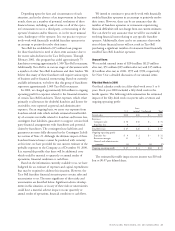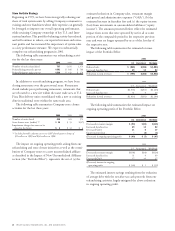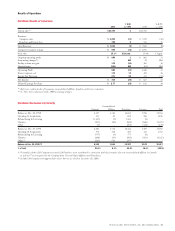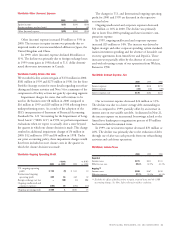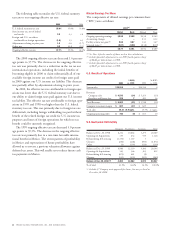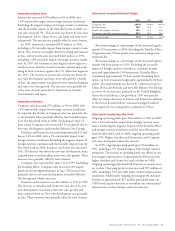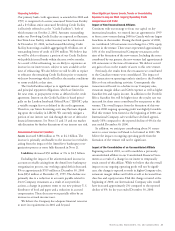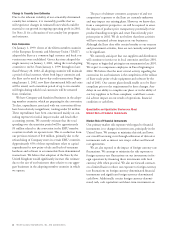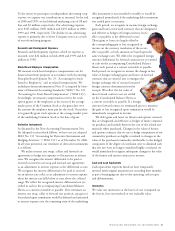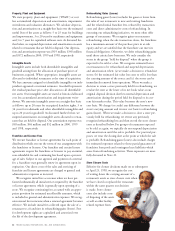Pizza Hut 2000 Annual Report Download - page 39
Download and view the complete annual report
Please find page 39 of the 2000 Pizza Hut annual report below. You can navigate through the pages in the report by either clicking on the pages listed below, or by using the keyword search tool below to find specific information within the annual report.TRICON GLOBAL RESTAURANTS, INC. AND SUBSIDIARIES 37
Financing Activities
Our primary bank credit agreement, as amended in 2000 and
1999, is comprised of a senior, unsecured Term Loan Facility
and a $3 billion senior unsecured Revolving Credit Facility
(collectively referred to as the “Credit Facilities”), both of
which mature on October 2, 2002. Amounts outstanding
under our Revolving Credit Facility are expected to fluctuate,
but Term Loan Facility reductions may not be reborrowed.
At December 30, 2000, we had unused Revolving Credit
Facility borrowings available aggregating $1.8 billion, net of
outstanding letters of credit of $190 million. We believe that
we will be able to refinance a portion of our Credit Facilities
with publicly issued bonds within the next twelve months.
As a result of this refinancing, we are likely to experience an
increase in our interest rates, subject to rates available at the
time of refinancing. We also believe we will be able to replace
or refinance the remaining Credit Facilities prior to maturity
with new borrowings which will reflect the market conditions
or terms available at that time.
The Credit Facilities subject us to significant interest expense
and principal repayment obligations, which are limited in
the near term, to prepayment events as defined in the credit
agreement. Interest on the Credit Facilities is based princi-
pally on the London Interbank Offered Rate (“LIBOR”) plus
a variable margin factor as defined in the credit agreement.
Therefore, our future borrowing costs may fluctuate depend-
ing upon the volatility in LIBOR. We currently mitigate a
portion of our interest rate risk through the use of derivative
financial instruments. See Notes 11 and 13 and our market
risk discussion for further discussions of our interest rate risk.
Consolidated Financial Condition
Assets increased $188 million or 5% to $4.1 billion. The
increase is primarily attributable to the increase in receivables
arising from the impact of the AmeriServe bankruptcy reor-
ganization process as more fully discussed in Note 21.
Liabilities decreased $50 million or 1% to $4.5 billion.
Excluding the impact of the aforementioned increase in
accounts receivable arising from the AmeriServe bankruptcy
reorganization process, our working capital deficit decreased
8% to approximately $769 million at December 30, 2000
from $832 million at December 25, 1999. The decline was
primarily due to a reduction in accounts payable related to
fewer Company restaurants as a result of our portfolio
actions, a change in payment terms to our new primary U.S.
distributor of food and paper and a reduction in accrued
compensation. These decreases were partially offset by an
increase in accrued income taxes.
We believe the Company has adequate financial resources
to meet its requirements in 2001 and beyond.
Other Significant Known Events, Trends or Uncertainties
Expected to Impact 2001 Ongoing Operating Profit
Comparisons with 2000
Impact of New Unconsolidated Affiliates
Consistent with our strategy to focus our capital on key
international markets, we entered into an agreement in 1999
to form a new venture during 2000 in Canada with our largest
franchisee in that market. During the third quarter of 2000,
we contributed 320 restaurants in exchange for a 50% equity
interest in the venture. These stores represented approximately
16% of the total International Company restaurants at the
time of the formation of the new venture. Including the stores
contributed by our partner, the new venture had approximately
650 restaurants at the time of formation. We did not record
any gain or loss on the transfer of assets to this new venture.
Previously, the results from the restaurants we contributed
to the Canadian venture were consolidated. The impact of
this transaction on operating results is similar to the Portfolio
Effect of our refranchising activities. Consequently, this
transaction will result in a decline in our Company sales,
restaurant margin dollars and G&A expenses as well as higher
franchise fees and equity income. In addition to the Portfolio
Effect, franchise fees will be higher since the royalty rate was
increased for those stores contributed by our partner to this
venture. The overall impact from the formation of this ven-
ture on 2000 ongoing operating profit was slightly favorable.
Had this venture been formed at the beginning of 2000, our
International Company sales would have declined approxi-
mately 10% compared to the reported decline of 4% for the
year ended December 30, 2000.
In addition, we anticipate contributing about 50 restau-
rants to a new venture in Poland to be formed in 2001. We
believe the impact on ongoing operating profit from the
formation of the venture will not be significant.
Impact of the Consolidation of an Unconsolidated Affiliate
Beginning in fiscal 2001, we will consolidate a previously
unconsolidated affiliate in our Consolidated Financial State-
ments as a result of a change in our intent to temporarily
retain control of this affiliate. While we believe that the overall
impact on our ongoing operating profit will not be signifi-
cant, this change is expected to result in higher Company sales,
restaurant margin dollars and G&A as well as decreased fran-
chise fees and equity income. Had this change occurred at the
beginning of 2000, our International Company sales would
have increased approximately 2% compared to the reported
decline of 4% for the year ended December 30, 2000.


